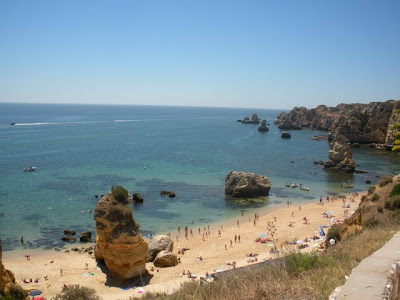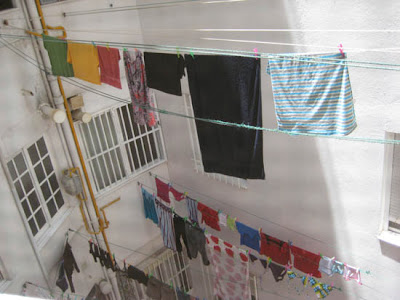With Spain mastered, 15 of the students decided to take on Portugal last weekend. This is James' account of the weekend. A complete set of his photos are located at this link: Lagos Photo Album.
This is James.

This past weekend 14 of my classmates and I decided to take a trip to someplace warm. A place where the beer flows like wine. Where beautiful women instinctively flock like the salmon of Capistrano. I’m talking about a little place called Lagos.

We started our trip Friday at 1:30, at the Plaza de Armas bus station, where we boarded for a short 4 hour bus ride to our destination in Lagos. Once we arrived in Lagos we decided to explore the city, and by explore the city I mean look for our hostel. While walking around nearly the entire little city we were able to see the beautiful ocean along with little white buildings that made up almost the entire city's hilly and curvy streets. After “exploring” the city for nearly 45 minutes we stumbled across our hostels, which in our favor happened to be right across the street from each other. Half of us stayed in the Casa Sauza while the other half stayed in the Carlos House. I can’t speak for the lads in the Carlos house but our room in the Casa Sauza had a bunk bed and 3 smaller beds right next to it, along with a wonderful balcony(with a table and 4 chairs none the less) and a small bathroom with a shower, toilet, and sink. Also right outside our room was a little kitchen to help us get by without making too big of a dent to the wallet or purse.

Upon settling in we talked to the very helpful guy working at the Casa Sauza to learn where everything in Lagos we could possibly need was. By this time we were all pretty hungry and wanted to go grab a bite to eat, but first we had some grocery shopping to do. We bought everything we needed to hold us over for the weekend, or most of the weekend at least. Speaking very little Portuguese at the store was no problem because most of the people in Portugal new English which became a real treat the entire trip.
After returning the groceries to the hostel it was time to go eat. Carlos informed us about a cheap restaurant to eat at called Casa Rosa. When we got there the place was packed and there were no places to sit. We waited a short 5 minutes and actually got a really long table that was connected next to the Spanish group (just a coincidence). The menu was pretty simple, 3.95 euros per plate, and if I remember correctly consisted of a pork platter, hamburger, spaghetti (all you can eat for an hour), ribs (which they didn’t have at the time), chicken burrito, and more that I can't remember off the top of my head.

After the meal we walked back to the hostel to get ready to adventure into the Lagos nightlife. We discovered that you can't walk more than 5 minutes without someone approaching and promoting their bar or club, which made the 10 minute walk into 20 minutes. We then went out to discover a pretty upbeat nightlife with tons of places to go within a small distance of each other. Throughout the course of the night we split up into small groups with plenty of good stories to tell the following morning.
As the night turned into day we awoke with a plan to go to the beach. Like usual, it is hard to get the entire group to get moving at the same time. The group I went with quickly got lost and ran into a few dead ends where we thought we could possibly get through. After correcting our mistakes we arrived in what I thought was paradise. It had to be one of the most beautiful beaches I have ever seen, it was covered with rocky cliffs and crystal clear water. I guess you can say it paid off to get a little lost. As it seems to be a trend with all the beaches that I have been to in Spain and Portugal, the water was extremely cold. That entire Saturday was spent leisurely hanging out on the beach, visiting the nearby cave, going to other coves, and climbing the nearby cliffs to get unbelievable views of the entire beach and city. Oh and have I mentioned all the beautiful people that Portugal seems to attract. Very impressive. Some of us liked the beach so much (me, Carson, and Kyle) that we stayed the entire day and were the very last people to leave the beach that we were on.



Eventually we went back to the hostel to shower up and make some dinner. Our very wonderful chef Chris decided to make a monster size bowl of pasta that could have fed a small nation (any single ladies looking for a man that can cook, Chris is available). The pasta turned out great, and I believe fed almost our entire group. Being exhausted I did not go out that night, but others did and had another great night in Lagos. The next morning the girls, along with ladies man Chris, went kayaking and as far as I know went pretty good. The others took another trip down to the beach to relax until we had to be at the bus station by 4.
All and all the weekend was a great success and I could definitely see myself returning to Portugal. The atmosphere there was one of a kind. Great beaches, beautiful scenery, extremely nice people, it’s hard not to like. Also it seemed to have an endless amount of touristic things to do. Some of the things I can remember are kayaking, taking a boat to see the caves, go dolphin watching, parasailing, jet skiing, they even had a zoo. More than enough to do in a weekend.






















































